Examples of compact embedded convex -hypersurfaces
Abstract.
In the paper, we construct compact embedded convex -hypersurfaces which are diffeomorphic to a sphere and are not isometric to a standard sphere. As the special case of our result, we solve Sun’s problem (Int Math Res Not: 11818-11844, 2021). In this sense, one can not expect to have Alexandrov type theorem for -hypersurfaces.
1. Introduction
A hypersurface is called a -hypersurface if it satisfies
| (1.1) |
where is a constant, is the position vector, is an inward unit normal vector and is the mean curvature. The notation of -hypersurfaces were first introduced by Cheng and Wei in [5] (also see [17]). Cheng and Wei [5] proved that -hypersurfaces are critical points of the weighted area functional with respect to weighted volume-preserving variations. This equation of -hypersurfaces also arises in the study of isoperimetric problems in weighted (Gaussian) Euclidean spaces, which is a long-standing topic studied in various fields in science. -hypersurfaces can also be viewed as stationary solutions to the isoperimetric problem in the Gaussian space. For more information on -hypersurfaces, one can see [5] and [17].
Firstly, we give some examples of -hypersurfaces. It is well known that there are several special complete embedded solutions to (1.1):
-
•
hyperplanes with a distance of from the origin,
-
•
sphere with radius centered at origin,
-
•
cylinders with an axis through the origin and radius .
In [6], Cheng and Wei constructed the first nontrivial example of a -hypersurface which is diffeomorphic to by using techniques similar to Angenent [2]. In [18], using a similar method to McGrath [16], Ross constructed a -hypersurface in which is diffeomorphic to and exhibits a rotational symmetry. In [15], Li and Wei constructed an immersed -hypersurface using a similar method to [9]. It is quite interesting to find other nontrivial examples of -hypersurfaces.
Secondly, we introduce some rigidity results about -hypersurfaces. If , , then is a self-shrinker of mean curvature flow, which plays an important role for study on singularities of the mean curvature flow. Abresch and Langer [1] proved that the only -dimensional compact embedded self-shrinker is the circle. Huisken [14] proved any compact embedded, and mean convex () self-shrinkers are spheres. Later, Colding and Minicozzi [7] generalized Huisken’s results to the case of complete self-shrinkers.
If , there are relatively few results about -hypersurfaces. In [5], Cheng and Wei proved that generalized cylinders , are the only complete embedded -hypersurfaces with polynomial volume growth in if and , where , , denotes the components of the second fundamental form. This classification result generalizes the result of Huisken [14] and Colding and Minicozzi [7].
For , in [13], Heilman proved that convex -dimensional -hypersurfaces are generalized cylinders if , which generalized the rigidity result of Colding and Minicozzi [7] to -hypersurfaces with .
The case is much more complicated. In [12], by using the explicit expressions of the derivatives of the principal curvatures at the non-umbilical points of the surface, Guang obtained that any strictly mean convex -dimensional -hypersurfaces are convex if . Later, by using the maximum principle, Lee [11] showed that any compact embedded and mean convex -dimensional -hypersurfaces are convex if . In [4], Chang constructed -dimensional -curves in , which are not circles. These surprising examples show that -surfaces behave very differently when compared to the case . New techniques must be introduced to study this phenomenon. We imagine these examples may carry meaningful information in probability theory (also see [19]).
In [19], Sun developed the compactness theorem for -surface in with uniform and genus. As the application of the compactness theorem, he also showed a rigidity theorem for convex -surfaces. In the same paper, he [19] proposed the problem that constructing a compact convex -surface which is not a sphere (see Question 4.0.4. on page 25, [19]).
In this paper, motivated by [9, 10, 15, 19], we construct nontrivial embedded -hypersurfaces which are diffeomorphic to and they are not isometric to a standard sphere. As the special case of our result, that is, , we solve Sun’s problem. In fact, we obtain the following theorem:
Theorem 1.1.
For and , there exists an embedded convex -hypersurface which is diffeomorphic to and is not isometric to a standard sphere.
Remark 1.1.
It is well-known that for compact embedded hypersurfaces with constant mean curvature in , Alexandrov theorem holds, that is, a compact embedded hypersurface with constant mean curvature in is isometric to a round sphere. But for -hypersurfaces, one can not expect to have Alexandrov type theorem for -hypersurfaces according to the above theorem 1.1.
Remark 1.2.
For self-shrinkers, there is a well-known conjecture asserts that the round sphere should be the only embedded self-shrinker which is diffeomorphic to a sphere. Brendle [3] proved the above conjecture for -dimension self-shrinker. For the higher dimensional self-shrinker, the conjecture is still open. But for -hypersurfaces, we can construct compact embedded -hypersurface which is diffeomorphic to a sphere and is not isometric to a round sphere.
Remark 1.3.
For , Chang [4] proved that there exists a compact embedded -curve with -symmetry in , which is not a circle.
2. Preliminaries
Let denote the special orthogonal group and act on in the usual way, then we can identify the space of orbits with the half plane under the projection (see [18])
If a hypersurface is invariant under the action , then the projection will give us a profile curve in the half plane, which can be parametrized by Euclidean arc length and write as . Conversely, if we have a curve parametrized by Euclidean arc length in the half plane, then we can reconstruct the hypersurface by
| (2.1) |
Let
| (2.2) |
where the dot denotes taking derivative with respect to arc length . A direct calculation shows that is an inward unit normal vector for the hypersurface. Then we can calculate that the principal curvatures of hypersurface (see [6, 8]):
| (2.3) | ||||
Hence the mean curvature vector equals to
| (2.4) |
and then, by (2.1), (2.2) and (2.4), equation (1.1) reduces to (see also [6, 10, 18])
| (2.5) |
where . Let denote the angles between the tangent vectors of the profile curve and -axis, then (2.5) can be written as the following system of differential equation:
| (2.6) |
Let denote the projection from to . Obviously, if is a solution of (2.6), then the curve will generate a -hypersurface by (2.1). If we can, by this way, find a curve that starts and ends on the -axis and is perpendicular to the -axis at both ends, then we obtain an embedded -hypersurface, which is diffeomorphic to a sphere. Hence, Theorem 1.1 will be proved. By some symmetry of (2.6), a curve that starts perpendicularly on the -axis and ends perpendicularly on the -axis will also solve the problem. This paper’s main goal is to find the latter.
Letting be a point in , by an existence and uniqueness theorem of the solutions for first order ordinary differential equations, there is a unique solution to (2.6) satisfying initial conditions . Moreover, the solution depends smoothly on the initial conditions. Note that (2.6) has a singularity at due to the term . But there is also an existence and uniqueness theorem for (2.6) with initial conditions at singularity and . And the previously mentioned smooth dependence can also extend to singularity smoothly (see [9]).
When the profile curve can be written in the form , by (2.6), the function satisfies the differential equation
| (2.7) |
When the profile curve can be written in the form , by (2.6), the function satisfies the differential equation
| (2.8) |
Next we consider equations (2.6) in polar coordinates, when the profile curve can be written in the form , where and , the function satisfies the differential equation
| (2.9) |
Note that (2.8) has a solution , which corresponds to hyperplane, (2.9) has a solution , which corresponds to the round sphere.
We conclude this section with a lemma about the solutions of (2.8), this lemma can be found in [15].
3. Behavior near the known solutions
In order to solve the problem, we need to study the behavior near two known solutions first, and use continuity argument to find the curve that we want to have.
3.1. Behavior near the plane
Let be the solution of (2.8) with and where ′ denotes . For , by Lemma 2.1, let denote the point where blows-up, and let . Let , we may write to , to , to and to when there is no ambiguity. We introduce the following proposition which gives a description of the behavior near the plane .
Proposition 3.1.
For any fixed , , there exists so that
for .
To prove the proposition, we need several information on under small .
Lemma 3.1.
If , , then .
Proof.
Since , , and , there exists so that . Then also equals to . For , we have
where we have used that in the last inequality. Integrating from ,
Hence, we obtain for , . ∎
Lemma 3.2.
For any fixed , , there exists so that i.e., has a solution in for .
Proof.
We adopt an argument from the appendix B of [10]. In order to understand the behavior of when is close to 0, we study the linearization of the rotational -hypersurface differential equation (2.8) near the plane . We define by
Since satisfies equation
by differentiating the above equation with respect to and letting , we obtain a differential equation for :
| (3.1) |
with and , where we have used . We will show that and which lead to the lemma.
Defining , the (3.1) becomes into the following differential equation:
| (3.2) |
with the initial conditions at :
The equation (3.2) is one of the classical differential equations, namely a confluent hypergeometric equation. Up to a dilation of the argument , the solutions used here are called Kummer functions. Taking derivatives of (3.2), we have the following second order differential equation:
| (3.3) |
with the initial conditions at :
We also note that the differential equation (3.3) for satisfies a maximum principle, which yields that and then . Hence is strictly concave and strictly decreasing on . Combining this fact with and we obtain . Let in (3.2), we get . Now we have proved that and , i.e., and . ∎
Lemma 3.3.
Suppose , . If there exists a point so that , we have
for .
Proof.
Let . We want to show that for . If , then . If , by a direct computation, we obtain
that is, for .
Suppose for some . Then and there exists a point so that and for . This implies that and . On the other hand, since
where we have used that , and in the last inequality, this contradicts . Hence, we complete the proof. ∎
Proof of Proposition 3.1. The first part of the proposition 3.1 has been shown in the lemma 3.1. We know that for from the lemma 3.1. In particular, for . Choosing and assuming , by the lemma 3.2 and lemma 3.3, we have (that is, ) and
We will extend this estimate for to an estimate for . For , we have
where we have used that and in the last inequality.
Integrating the previous inequality from to , implies
for . Since , we have
| (3.4) |
for . At , this tells us that
Finally, integrating (3.4) from to , we have
and therefore
Hence , this competes the proof. ∎
3.2. Behavior near the round sphere
As in the proof of the lemma 3.2, we also make use of the method from the appendix B of [10]. Recall equation (2.9), if we can write the profile curve in the form in polar coordinates, where and , then (2.9) tells us that satisfies
| (2.8) |
This ordinary differential equation has a constant solution
which corresponds to the round sphere. We note that this equation has a singularity when due to the term. Let be the solution to (2.8) with initial conditions and . As is Drugan and Kleene said in [10], for , the solution is smooth when and is close to 0. This is also true for .
In order to understand the behavior of when is close to 0, we study the linearization of
the rotational self-shrinker differential equation near the round sphere . We define by
Then satisfies the (singular) linear differential equation:
| (3.5) |
with and . Letting , we may write for when there is no ambiguity. Note that the sign of is positive for . In the following lemma, we claim that and which yields that, for and closed to , and at the first point where the profile curve meets -axis.
Lemma 3.4.
Let , be the solution to (3.5) with and . Then and .
Proof.
By making use of the substitution , (3.5) becomes into the following Legendre type differential equation:
| (3.6) |
with the initial conditions at :
To prove the lemma, we need to show that satisfies and .
Taking derivatives of (3.6), we have the following second order differential equations:
| (3.7) | |||
| (3.8) |
It follows from (3.7) and (3.8) that
By a direct calculation, we get that
for , and we also get
. Then one can obtain by solving inequality . Summing up, we have and for , which tell us that
and . We also note that the differential equation (3.8) for satisfies a maximum principle since .
Using the same method as in [10], we can obtain and , which follows from (3.6) and (3.7) that and . Regarding as a function of , this says that and , which proves the lemma.
∎
4. Proof of the theorem
Proof of Theorem 1.1. Let denote the solution to (2.6) with initial conditions . According to the lemma 2.1 we know that, for , the first component of written as a graph over the -axis is concave down and decreasing before it blows-up at the point . The proposition 3.1 tells us that when and closed to , is in the first quadrant. From the lemma 3.4 we know that when and closed to , is in the second quadrant. Since the mapping is continuous, the previous results imply that there exists such that lies in -axis. Suppose , then the curve will generate an embedded -hypersurface by (2.1), which is diffeomorphic to a sphere and is not isometric to the sphere . Moreover, by (2.3) and lemma 2.1, all the principal curvatures of the hypersurface we construct is positive. In other words, the hypersurface we construct is convex. ∎
Remark 4.1.

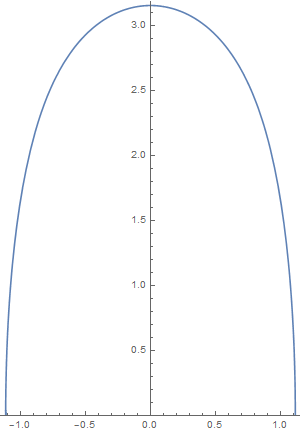
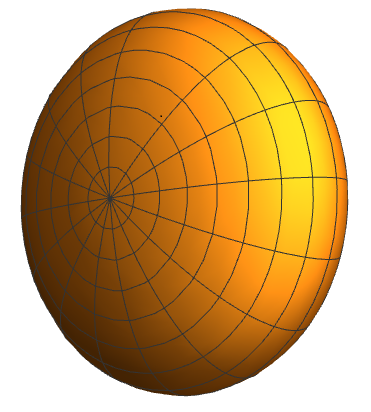
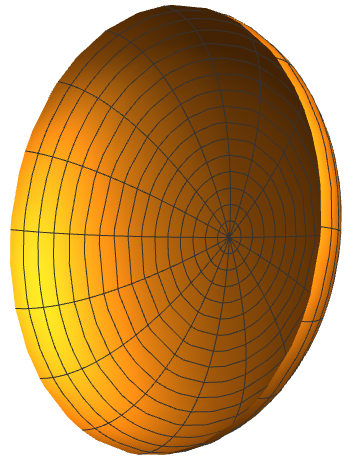
Remark 4.2.
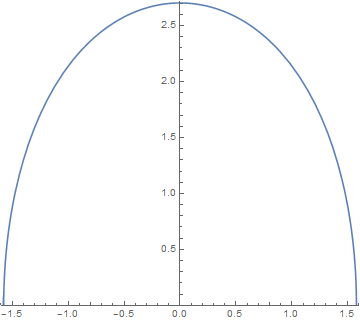
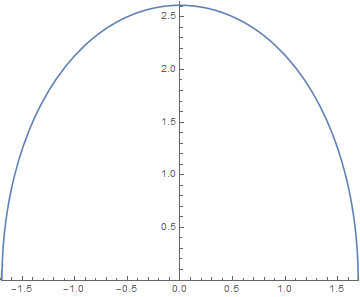
References
- [1] U. Abresch and J. Langer, The normalized curve shortening flow and homothetic solutions, J. Differential Geom. 23 (1986), 175šC196.
- [2] S. B. Angenent, Shrinking doughnuts Birkhaüser, Boston-Basel-Berlin, 7, 21-38, 1992.
- [3] S. Brendle, Embedded self-similar shrinkers of genus 0, Ann. of Math. 183 (2016), 715-728.
- [4] J. -E. Chang, 1-dimensional solutions of the -self shrinkers, Geom. Dedicata 189 (2017), 97-112.
- [5] Q. -M. Cheng and G. Wei, Complete -hypersurfaces of weighted volume-preserving mean curvature flow, Cal. Var. Partial Differential Equations 57 (2018), 32.
- [6] Q. -M. Cheng and G. Wei, Examples of compact -hypersurfaces in Euclidean spaces, Sci. China Math. 64 (2021), 155-166.
- [7] T. H. Colding and W. P. Minicozzi II, Generic mean curvature flow I; generic singularities, Ann. of Math. 175 (2012), 755-833.
- [8] M. do Carmo and M. Dajczer, Hypersurfaces in space of constant curvature, Trans. Amer. Math. Soc. 277 (1983), 685-709.
- [9] G. Drugan, An immersed self-shrinker. Trans. Amer. Math. Soc. 367 (2015), 3139-3159.
- [10] G. Drugan and S. J. Kleene, Immersed self-shrinkers, Trans. Amer. Math. Soc. 369 (2017), 7213-7250.
- [11] T. -K. Lee, Convexity of -hypersurfaces, Proc. Amer. Math. Soc. 150 (2022), 1735-1744.
- [12] Q. Guang, A note on mean convex -surfaces in , Proc. Amer. Math. Soc. 149 (2021), 1259-1266.
- [13] S. Heilman, Symmetric convex sets with minimal Gaussian surface area, Amer. J. Math. 143 (2021), 53-94.
- [14] G. Huisken, Asymptotic behavior for singularities of the mean curvature flow, J. Differential Geom. 31 (1990), 285šC299.
- [15] Z. Li and G. Wei, An immersed -hypersurface, J. Geom. Anal. 33 (2023), Paper No. 288, 29 pp.
- [16] P. McGrath, Closed mean curvature self-shrinking surfaces of generalized rotational type, arXiv: 1507.00681. 2015.
- [17] M. McGonagle and J. Ross, The hyperplane is the only stable, smooth solution to the isoperimetric problem in Gaussian space, Geom. Dedicata 178 (2015), 277-296.
- [18] J. Ross, On the existence of a closed, embedded, rotational -hypersurface, J. Geom. 110 (2019), 1-12.
- [19] A. Sun, Compactness and rigidity of -surfaces, Int. Math. Res. Not. IMRN (2021), 11818-11844.